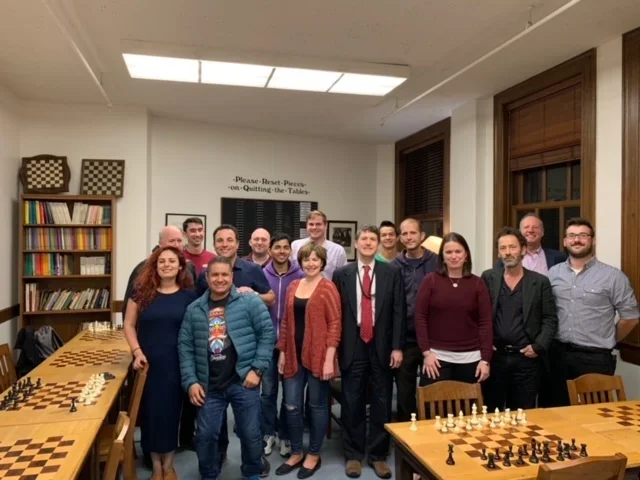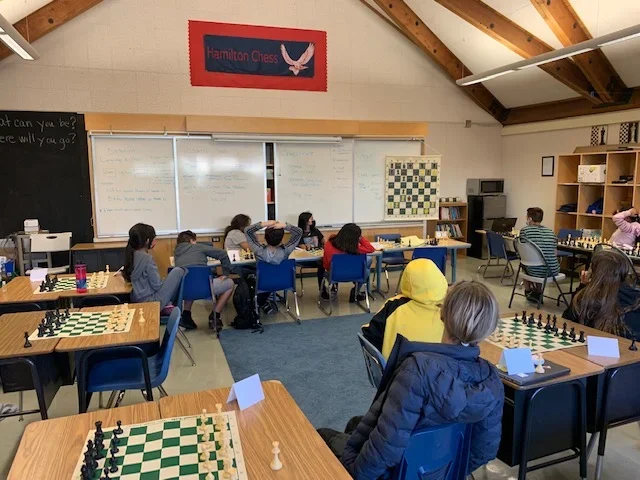As I reflect on my experiences in the chess world – first at the scholastic level, then working primarily with an adult community, and now back to kids – I think about the common thread, that makes chess a special and unique unifier, and about what makes a chess club successful.
I started a chess club in 2012 called Castling Kids that provided after-school chess classes in elementary schools. While the weekday after-school programs introduced kids to chess in a fun, casual way to inspire them to learn, we also had a weekend club where we organized kids from our programs to compete in local scholastic events. The expectations were higher for the coaches, the players, and myself. We tried to form an identity and a culture, taking pride and personal investment in the club. We were small, but we were a team, and we all looked forward to those Saturday morning sessions and competitions.

In 2018, I went to the Mechanics’ Institute to take over as Chess Director from IM John Donaldson, who was retiring after 20 years. Founded in 1854, the Mechanics’ Institute is the oldest continuously running chess club in the United States and is primarily considered an adult chess community, though interest in scholastic chess has recently grown.
In managing this storied organization, it was critical to take feedback and make decisions that felt consistent with the history and culture of the club – expanding offerings in events and classes to cater to the established adult audience, while introducing and growing chess programming in schools and offering regular scholastic rated events. To do this, I took a personal approach to interacting with players, getting to know them as people, as well as chess players.
The Institute also had an important history we wanted to share, so we created a voice linking the club to the community using methods old and new. We utilized the Mechanics’ Institute newsletter which had contributions from the department staff, as well as live streaming platforms to bring our events to a wider audience.

But directing an institute with over a hundred years of history is significantly different than my newest post at Hamilton Meadow Park School. The school is a public K-8 school in which 67% of students are Hispanic, and where nearly 100 students participated in the chess club prior to COVID-19. Their program was developed by parent volunteers Michele Huff and Jay Ferguson and then led by WGM Carla Heredia.
Here, the goal will be to develop programs for recreational and competitive players, but more importantly, to develop a culture and identity for the chess club and create an environment where players feel welcome, motivated, excited, and invested. As we did at Mechanics’ Institute, we’ll strive to create a voice that speaks to the community and help the kids have a voice in their program. We will try to nurture an additional source of pride for the school and community with investment from players, parents, and the school.
We hope to show how chess in schools is a particularly special and unique opportunity for kids to develop so many skills that are useful throughout life both on and off the chessboard – skills like critical thinking, sportsmanship, and persevering through adversity. For us, success will be measured by not only making better players, but better people.

Chess is for everyone, and a chess club adds value to a community, bringing people of all backgrounds together. If you take the time to listen and learn about your chess community, you will find that it is the key to creating a successful club that is welcoming and rewarding.
You don’t have to go it alone either. US Chess has a very useful and up-to-date guide for anyone looking to start a club, which you can find here.
Also, the US Chess Clubs Committee is here to help any club looking to start or develop – just Click here to show email address.
Categories
Archives
- December 2025 (24)
- November 2025 (29)
- October 2025 (39)
- September 2025 (27)
- August 2025 (29)
- July 2025 (43)
- June 2025 (25)
- May 2025 (24)
- April 2025 (29)
- March 2025 (29)
- February 2025 (20)
- January 2025 (24)
- December 2024 (34)
- November 2024 (18)
- October 2024 (35)
- September 2024 (23)
- August 2024 (27)
- July 2024 (44)
- June 2024 (27)
- May 2024 (31)
- April 2024 (51)
- March 2024 (34)
- February 2024 (25)
- January 2024 (26)
- December 2023 (29)
- November 2023 (26)
- October 2023 (37)
- September 2023 (27)
- August 2023 (37)
- July 2023 (47)
- June 2023 (33)
- May 2023 (37)
- April 2023 (45)
- March 2023 (37)
- February 2023 (28)
- January 2023 (31)
- December 2022 (23)
- November 2022 (32)
- October 2022 (31)
- September 2022 (19)
- August 2022 (39)
- July 2022 (32)
- June 2022 (35)
- May 2022 (21)
- April 2022 (31)
- March 2022 (33)
- February 2022 (21)
- January 2022 (27)
- December 2021 (36)
- November 2021 (34)
- October 2021 (25)
- September 2021 (25)
- August 2021 (41)
- July 2021 (36)
- June 2021 (29)
- May 2021 (29)
- April 2021 (31)
- March 2021 (33)
- February 2021 (28)
- January 2021 (29)
- December 2020 (38)
- November 2020 (40)
- October 2020 (41)
- September 2020 (35)
- August 2020 (38)
- July 2020 (36)
- June 2020 (46)
- May 2020 (42)
- April 2020 (37)
- March 2020 (60)
- February 2020 (38)
- January 2020 (45)
- December 2019 (34)
- November 2019 (35)
- October 2019 (42)
- September 2019 (45)
- August 2019 (56)
- July 2019 (44)
- June 2019 (35)
- May 2019 (40)
- April 2019 (48)
- March 2019 (61)
- February 2019 (39)
- January 2019 (30)
- December 2018 (29)
- November 2018 (51)
- October 2018 (45)
- September 2018 (29)
- August 2018 (49)
- July 2018 (35)
- June 2018 (31)
- May 2018 (39)
- April 2018 (31)
- March 2018 (26)
- February 2018 (33)
- January 2018 (30)
- December 2017 (26)
- November 2017 (24)
- October 2017 (30)
- September 2017 (30)
- August 2017 (31)
- July 2017 (28)
- June 2017 (32)
- May 2017 (26)
- April 2017 (37)
- March 2017 (28)
- February 2017 (30)
- January 2017 (27)
- December 2016 (29)
- November 2016 (24)
- October 2016 (32)
- September 2016 (31)
- August 2016 (27)
- July 2016 (24)
- June 2016 (26)
- May 2016 (19)
- April 2016 (30)
- March 2016 (36)
- February 2016 (28)
- January 2016 (32)
- December 2015 (26)
- November 2015 (23)
- October 2015 (16)
- September 2015 (28)
- August 2015 (28)
- July 2015 (6)
- June 2015 (1)
- May 2015 (2)
- April 2015 (1)
- February 2015 (3)
- January 2015 (1)
- December 2014 (1)
- July 2010 (1)
- October 1991 (1)
- August 1989 (1)
- January 1988 (1)
- December 1983 (1)







